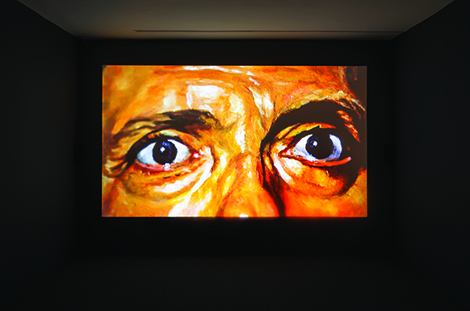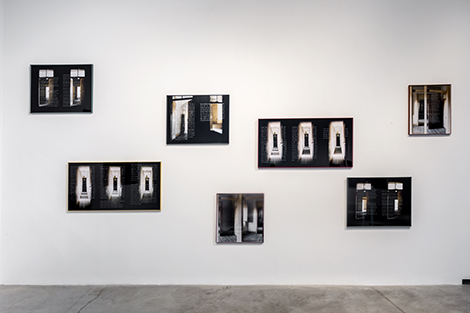Vasco Araújo’s “Under the Influence of Psyche” features works of various media that draw on the traditions of art, literature, opera, dance and music to construct new narratives demonstrating the instability of the canon. Happy Days (2006) records the stage directions from Samuel Beckett’s 1960 play across the glass of framed photographs of interiors, primarily corridors and doorways. Araújo omits the dialogue, allowing the viewer to construct a story based solely on the actions. The video Vulcano (2012) shows paintings of volcanoes and distressed individuals, linking psychological turmoil to the volatile natural force.
The newest work, Retrato [Portrait] (2014) continues Araújo’s interrogation of the canon, while also exploring identity as it connects to Portugal’s colonial history. This video shows reproductions of portraits by 20th-century Portuguese painter Eduardo Malta who worked prior to decolonization in the 1970s. Voiceovers in English and at least three Romance languages imply a conversation amongst those who are depicted but unidentified. The majority of the subjects are white aristocrats, but two people of African descent become representative of Portugal’s role in the slave trade.
Retrato opens with a portrait of a white woman saying, “I’m already inside… I may have built the walls.” She states that this is her love story, a sentiment echoed by several other aristocrats. From their perspective, colonization is a love story. This assertion is colored by the tragic tale associated with the dramatic soundtrack, which features music from Richard Wagner’s opera Tristan und Isolde. The video cuts to an exterior view of a white building, presumably the dwelling in which the portraits are displayed. Later in the video a portrait of a black man speaks: “I’m symbolic… I don’t know my story because I don’t have anything that’s mine… I’m out there and can’t come in.” He becomes a synecdoche for the colonized within a power dynamic that she, and other whites, helped construct.
Toward the end of the video, a “chorus” of African wooden sculptures speaks: “We are the plural voice. Don’t look at our skin. Look at our eyes. We don’t have a place.” Adjacent to this group is a small reproduction of the Venus de Milo, who says she is searching for a place. In response, the “chorus” invites her to join them, suggesting that a symbol of the classical Western world be subsumed into a group of unidentified colonized people.
Araújo presents the Western representational tradition as a potentially mutable entity. The artist, as a white man, holds a challenging position when depicting subjugated people in Retrato. His inclusion of African sculptures and two portraits of black people in a film dominated by white characters risks tokenism. Araújo’s earlier works do not venture into such contested territory, which was explored in the 1980s and ’90s by artists such as Rebecca Belmore and Yinka Shonibare, whose work is informed by their personal experience of neo-colonialism. While there is potential for Araújo to contribute to a nuanced discourse, it is problematic to assume the voice of the “other,” and this work may perpetuate inherited inequalities.



